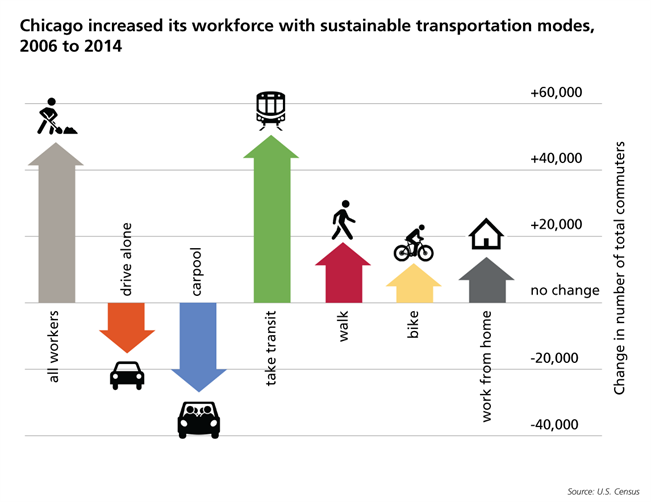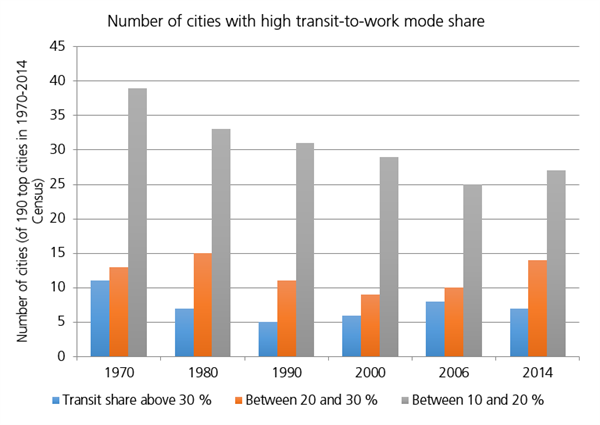
Flickr user clarkmaxwell (cc).
More and more people have been hopping onto trains and out of cars in Chicago.
Published monthly, MPC’s Talking Transit, supported by Bombardier, provides updates about transit-related activities around the world. Read In the Loop for the latest transportation headlines.
An environmentally responsible, socially equitable city must offer its residents and workers a wide variety of ways to get around. More than just offering access to people with automobiles, cities should provide effective public transportation and easy routes for walkers and bikers.
Between 2006 and 2014, Chicago was able to absorb all of its growth in workers—46,510 new commuters—on sustainable modes, including transit, biking and walking.
New data from the U.S. Census suggest that, after years of increasing driving, more Americans are taking advantage of commuting options like trains and bikes. But our society remains very much attached to its personal vehicles. In the U.S. as a whole, the overwhelming majority of people drive alone to work, and in many big cities, the share of workers taking transit remains far below levels 55 years ago.
Good news over the past eight years
Data released this month by the U.S. Census offers insight into commute trends in 2014 and suggests that cities across the country, on average, are slowly moving away from a reliance on single-passenger automobiles. The data is a sample—it features a significant margin of error and only accounts for commute trips, not all trips—but it provides a useful indication for how people are changing their commuting habits in the U.S.
As a whole, the nation moved slightly away from driving between 2006 and 2014, with a big drop in the share of people carpooling to work (the number of people driving alone to work increased by 6 percent). Meanwhile, transit use increased by 14 percent and accounted for 5.2 percent of commutes in 2014. The number of people commuting to work on a bike increased by 45 percent.

In the 228 largest cities for which there is data available for 2006 and 2014 (they account for 26 percent of total U.S. workers), the trend was more striking. Seventy-one percent of those cities had a reduced share of commuters driving to work alone, with the average city seeing a 1.4 percentage point decline in workers driving alone, a 0.3 percentage point increase in transit users, 0.4 percentage point increase in bikers and a 0.1 percentage point increase in walkers.
There are now 33 U.S. cities where less than 60 percent of commuters drive to work alone, versus 30 in 2006. This analysis does not evaluate metropolitan areas as a whole—it just compares results by residents of municipalities.
Chicago was representative of these overall trends, with a 5.9 percentage point drop in the share of commuters driving alone to work. Filling the gap was the transit system, which added 2.8 percentage points to its mode share (reaching 28 percent of commutes), biking, which added 0.8 points and walking, which added 1.3 percent. The increase in transit came entirely on the rail system; buses attracted fewer commuters than in 2006.
Between 2006 and 2014, Chicago was able to absorb all of its growth in workers—46,510 new commuters—on sustainable modes, including transit, biking and walking.

Chicago has made a particularly dramatic transition toward commuters choosing to bike or walk to work. Since 2000, the share of people in the City of Chicago choosing these low-impact transportation modes has increased from 6.2 percent to 8.4 percent in 2014. The City of Chicago’s investments in improved biking facilities and better sidewalks are paying off in increased commuter use.
Chicago ranks highly in many sustainable transportation categories
The City of Chicago’s investments in improved biking facilities and better sidewalks are paying off in increased commuter use.
Compared to other cities across the country, Chicago attracts a significant share of commuters traveling to work using transportation options other than driving alone. With 49 percent of commuters driving alone to work, Chicago ranks 13th in the country in terms of reliance on single-passenger automobiles. That’s far more than New York, where just 22 percent of commuters drive alone to work.
But Chicago is the second-least car-dependent city in the Midwest, after Evanston, where 48.7 percent of commuters travel to work in their cars alone. Major regional peers, including Minneapolis, St. Louis, Milwaukee and Indianapolis, are far more car reliant, with 60, 71, 72 and 82 percent of their commuters traveling alone by car, respectively.
As the following table of top cities by commuting method shows, Chicago also attracts a relatively high share of people to transit, biking and walking, particularly compared to the U.S. as a whole, where those modes attract a total of about 9 percent of workers, compared to 37 percent in Chicago.
|
Drive alone
|
|
Transit
|
|
Bike
|
|
Walk
|
|
1
|
New York, NY
|
22%
|
|
1
|
New York, NY
|
57%
|
|
1
|
Berkeley, CA
|
10%
|
|
1
|
Cambridge, MA
|
25%
|
|
2
|
Cambridge, MA
|
26%
|
|
2
|
Jersey City, NJ
|
49%
|
|
2
|
Boulder, CO
|
9%
|
|
2
|
Columbia, SC
|
21%
|
|
3
|
Berkeley, CA
|
31%
|
|
3
|
Union City, NJ
|
40%
|
|
3
|
Somerville, MA
|
7%
|
|
3
|
Berkeley, CA
|
20%
|
|
4
|
Jersey City, NJ
|
31%
|
|
4
|
Washington, DC
|
36%
|
|
4
|
Cambridge, MA
|
7%
|
|
4
|
Albany, NY
|
15%
|
|
5
|
Union City, NJ
|
32%
|
|
5
|
San Francisco, CA
|
34%
|
|
5
|
Portland, OR
|
7%
|
|
5
|
Ann Arbor, MI
|
14%
|
|
6
|
San Francisco, CA
|
34%
|
|
6
|
Boston, MA
|
34%
|
|
6
|
Eugene, OR
|
7%
|
|
6
|
Boston, MA
|
14%
|
|
7
|
Washington, DC
|
35%
|
|
7
|
Somerville, MA
|
34%
|
|
7
|
Ft Collins, CO
|
6%
|
|
7
|
Washington, DC
|
13%
|
|
8
|
Somerville, MA
|
36%
|
|
8
|
Silver Spring, MD
|
32%
|
|
8
|
Santa Barbara, CA
|
6%
|
|
8
|
New Haven, CT
|
13%
|
|
9
|
Boston, MA
|
39%
|
|
9
|
Cambridge, MA
|
30%
|
|
9
|
Madison, WI
|
5%
|
|
9
|
Somerville, MA
|
12%
|
|
10
|
Silver Spring, MD
|
46%
|
|
10
|
Quincy, MA
|
30%
|
|
10
|
Ann Arbor, MI
|
5%
|
|
10
|
Union City, NJ
|
12%
|
|
13
|
Chicago, IL
|
49%
|
|
12
|
Chicago, IL
|
28%
|
|
46
|
Chicago, IL
|
2%
|
|
31
|
Chicago, IL
|
7%
|
|
|
Major cities average
|
72%
|
|
|
Major cities average
|
7%
|
|
|
Major cities average
|
1%
|
|
|
Major cities average
|
4%
|
|
|
U.S. average
|
76%
|
|
|
U.S. average
|
5%
|
|
|
U.S. average
|
1%
|
|
|
U.S. average
|
3%
|
In terms of transit use, we’re still far behind where we once were
The reductions in reliance on single-passenger automobiles and increase in transit use in recent years in major cities have not yet, however, returned commuting patterns to what they were like 55 years ago.
As the following chart illustrates, the share of commuters using transit to get to work in five major U.S. cities with large transit systems—Chicago, New York, Philadelphia, San Francisco and Washington, D.C.—is lower in 2014 than it was in 1960. In the case of Chicago, 2014 Census figures reversed a negative trend for the first time in fifty years, but the 28 percent share of commuters using transit is significantly lower than the 44 percent share in Chicago in 1960.
New York has led the movement back to transit, with the share of commuters using transit in 2014 (57 percent) the highest level in that city since the 1970s.

Nationwide, the number of major cities with at least 10 percent of commuters using transit increased from 2006 to 2014, but remains significantly below 1970. Forty-eight cities had that rate of commuting in 2014, versus 63 in 1970.

Will recent trends continue?
The recent willingness of urban commuters to move toward transportation options other than single-passenger automobiles suggests that improvements such as renovated public transportation facilities and new bike lanes can be effective in encouraging people to get out of their cars. The same can be said for new transit-oriented development located adjacent to public transportation stops.
Our cities must encourage less congestion and less pollution, but there is no guarantee that their residents will get out of their cars. Further changes will require more investment. People will choose alternative commute options when good transit is offered between their houses and their jobs; they’ll get on bikes when they feel safe biking down the street.
The most recent Census data offers an encouraging sign about the future of commuting in America. But we still have work to do to expand options and encourage new, environmentally friendly modes of transportation.